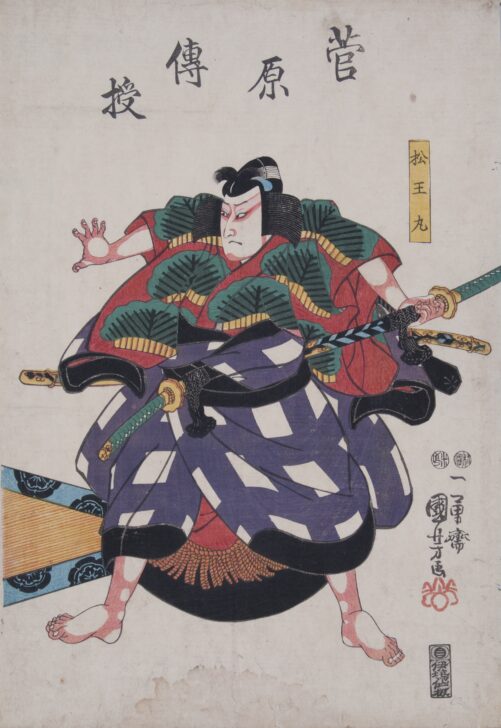Sugawara no Michizane and the Secrets of Calligraphy: Arashi Kichisaburō III as Matsuōmaru
Utagawa Kuniyoshi

Description
Subject Matter:
The play Sugawara no Michizane and the Secrets of Calligraphy first premiered in 1746 as a puppet play. It was adapted the next month for kabuki and remains one of the most famous and frequently performed in the kabuki repertoire. The narrative is based on the life of the famous scholar Sugawara no Michizane (845-903) who was exiled to Kyushu after being accused of treason. The scene depicted in this print, “Kurumabiki” or “Struggle for the Carriage”, shows the triplets Matsuomaru, Sakuramaru, and Umeomaru, and the villain of the play, Shihei. The scene’s tension of divided loyalties between the brothers and the conflicts between their emotions and their obligations is a major theme of this play. It is also representative of many plays written at the time. The use of triplets was inspired by the birth of triplets in Osaka which had caused a sensation, and each of the three is named for a tree. In this print, Matsuomaru (matsu= pine) is identifiable by the pine pattern on his robe.
Actor Arashi Kichisaburō III was born in 1810 and was active from 1821 until his death in 1864.
Physical Description:
In this print, a warrior prepares to fight. He holds one sword in his left hand, and several others are visible on his person. His robe has a pine pattern. A bamboo mat is visible at the left edge of the print.
This is the right panel of a tryptich (with 2011/2.199.1 and 2011/2.199.2).
Inscriptions: Sugawara denju; Matsuomaru; Kuniyoshi ga (Artist's signature); San, Ibasen han (Publisher's seal); Mera, Murata (Censors' seal)
Usage Rights:
If you are interested in using an image for a publication, please visit https://umma.umich.edu/request-image/ for more information and to fill out the online Image Rights and Reproductions Request Form.